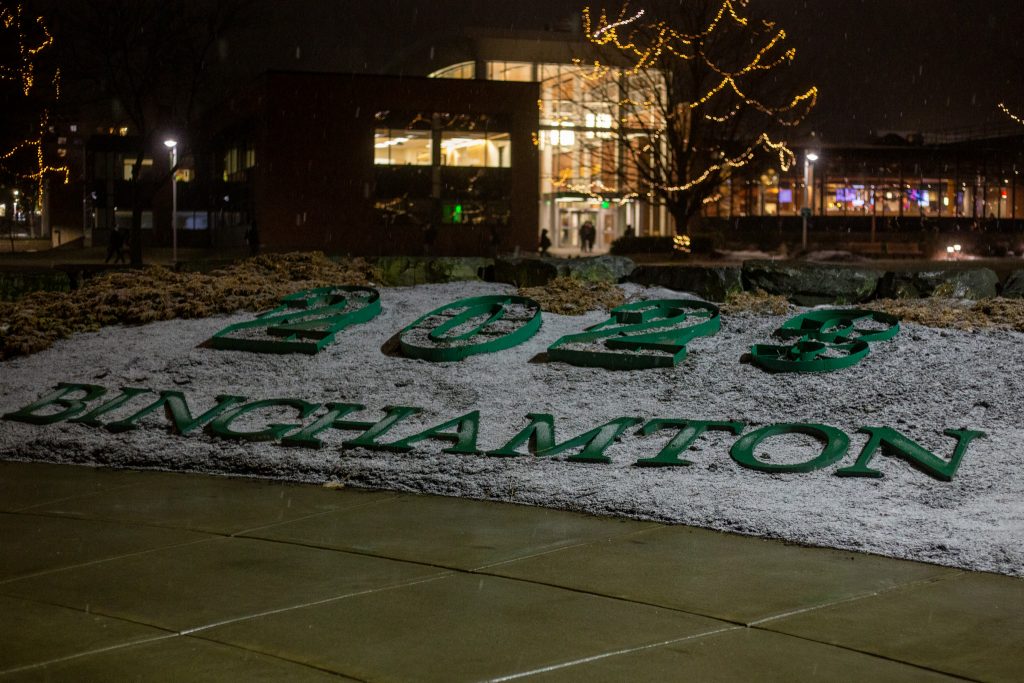Binghamton has been named one of the snowiest cities in the United States.
According to a recent list from Angi, Binghamton’s average snowfall of 61.9 inches over the past five years is sixth among all American cities. Two other cities in New York fall in the top 10 — Buffalo is fifth at 68.8 inches and Syracuse is fourth at 77.56 inches.
Mark Pellerito, the warning coordination meteorologist at the National Oceanic & Atmospheric Administration (NOAA) in Binghamton, outlined cold air, moisture and elevation as the three main causes of snowfall.
“You need access to those primary ingredients,” Pellerito said. “We have easy access to moisture from the Gulf of Mexico, or off the Atlantic coast, even from the Great Lakes, which contributes to lake effect snow. In terms of cold air, we get arctic air patterns that come right across from Canada. And compared to the city, we have greater elevation. Our station where the temperature is taken is at 1,600 feet. There are times where it may be raining in the valley, but it’s snowing up here [at the National Weather Service station], and that counts as snowfall.”
According to Pellerito, this winter Binghamton has experienced less-than-average snowfall. He cautioned against looking at the numbers now, as Binghamton’s winter weather season could stretch until April.
“As of Jan. 30, we have 35.3 inches of snow for the season,” Pellerito said. “We’re 10 inches short of where we usually are by the end of January — in an average winter, we will see 85 to 90 inches of snowfall. We still have plenty of winter to go, and remember, in December of 2020 we had a 40 inch [storm]. So, all it takes is one snowstorm to blow that [average] out of the water.”
Pellerito has worked for the NOAA since 2004, and has been stationed in Binghamton since 2011. Pellerito said he has noticed the impacts of climate change on snowfall, and discussed how temperature variance has affected weather patterns.
According to Pellerito, increased average temperatures may lead to less snow, but can make individual events more severe.
“With warmer temperatures, you also contain moisture,” Pellerito said. “You might think, this doesn’t look too bad, but because of the increased [moisture], the snow that does come down is more dense and likely to stick to the ground. So, even as temperatures are increasing, snowfall can be more intense.”
Ryan Yarosh, senior director of media and public relations at Binghamton University, discussed how the University works to handle weather-related events and potential cancellation of classes.
“The top priority will always be safety,” Yarosh wrote. “[BU’s] grounds crew begins plowing when there is a half-inch of snow accumulation. In fact, depending on the amount of snow, [upward] of 230 people may be involved in snow removal efforts. It is not unusual for grounds crews to work 80+ hours a week during periods of inclement weather. During severe storms, an outside contractor is used to supplement snow-removal efforts.”
Students who live off-campus have reported that snowfall makes their commute more difficult.
Daniel Croce — chairman and chief financial officer for Off-College Campus Transport (OCCT), vice president of finance for the Student Association and a junior majoring in business administration — offered perspective on how OCCT manages its bus fleet during severe weather.
“Overall, we follow [New York state] and local guidelines when it comes to operating safe service in inclement weather and are automatically put on alert when a storm warning begins,” Croce wrote in an email. “We continue to monitor both the road conditions (as reported by our drivers) and the updates from the weather authorities. We also make route modifications to ensure that we can get students home to all areas while avoiding less plowed/more difficult areas.”
While the snow may cause problems for many in the University community, some students offered a more positive outlook. Tori Sanberg, a senior majoring in biochemistry, looks forward to the yearly snowfall.
“I get so excited when I see it snow, even though I have to take an extra five minutes to brush my car off,” Sanberg said. “I really love seeing snow cover the ground and the trees. So to me, it outweighs the negatives.”



